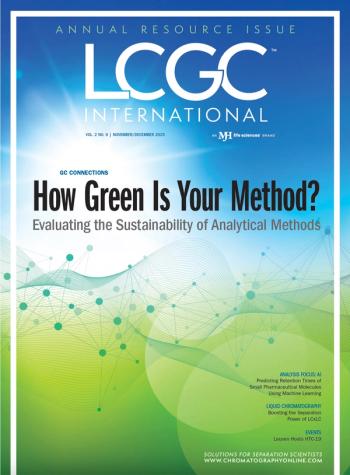
- The Column-11-23-2015
- Volume 11
- Issue 21
Screening Procedure for “Non Banned” Drugs
A new screening procedure has been developed for the detection of common “non banned” drugs used by athletes. The method targets multiple pharmacologically active compounds by liquid chromatography-electrospray ionization coupled to tandem mass spectrometry (LC-ESI-MS-MS).
A new screening procedure has been developed for the detection of common “non banned” drugs used by athletes. The method targets multiple pharmacologically active compounds by liquid chromatography-electrospray ionization coupled to tandem mass spectrometry (LC-ESI-MS-MS).1
The first “anti-doping list” was published in the mid-1960s and contained only substances active if taken immediately before or during competition. That list has been progressively expanded over the decades, and since 2002 the World Anti-Doping Agency (WADA) has taken over that duty. The list contains a myriad of substances from anabolic agents to hormone and metabolic modulators, which all require vigorous detection methods.
Seven selective serotonin reuptake inhibitors, four azole antifungal drugs, 19 benzodiazepine-like substances, five inhibitors of phosphodiesterase (PDE) type 4, and three inhibitors of PDE type 5 were targeted for detection in a urinary matrix. Urine samples were collected from patients currently being treated with the substances. Researchers at the Laboratorio Antidoping in Rome, Italy, used LC-ESI-MS-MS, which, once optimized, was validated according to ISO 170252 and WADA requirments.3
The targeted analytes were simultaneously identified using the newly developed LC-ESI-MS-MS procedure. The researchers believe that the application of this method can easily be included in the LC-MS-MS multi-analyte screening process currently used to detect banned compounds. This method significantly increases the information available of the (ab)use of the aforementioned classes of drugs among athletes. - L.B.
References
- M.Mazzarino et al., J. Pharm. Biomed. Anal117, 47-60 (2016).
- International Organization for Standardization, general requirements for the competence of testing and calibration laboratories, ISO: 17025.
- World Anti Doping Agency, Identification criteria for qualitative assays incorporating column chromatography and mass spectrometry, in: WADA Technical Document TD 2010IDCR, 2010, Available: http://www.wada-ama.org.
Articles in this issue
about 10 years ago
The Rise of Hydrophilic Interaction Chromatography (HILIC)about 10 years ago
Off-Line NMR Improves Traditional Chinese Medicine Analysisabout 10 years ago
Vol 11 No 21 The Column November 23, 2015 Europe and Asia PDFabout 10 years ago
Vol 11 No 21 The Column November 23, 2015 North American PDFabout 10 years ago
Split Injection GC: The Benefits of “Shoot-and-Dilute” GCabout 10 years ago
Rules of a Chromatographer’s LifeNewsletter
Join the global community of analytical scientists who trust LCGC for insights on the latest techniques, trends, and expert solutions in chromatography.



